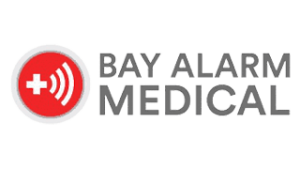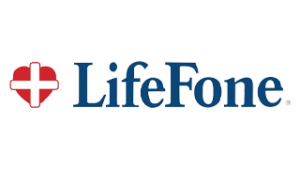Why LifeFone has the longest battery life
Battery life can be critical with medical alert systems. You can’t get help if your device is dead. With LifeFone, even if you forget to charge your device, you should be covered for up to 10 days with its VIPx GPS device. It’s easy to see why LifeFone is our choice for “Longest Battery Life.” It has twice the battery life of the next runner-up on this list (Medical Guardian with five days). It also charges faster. The VIPx charges in about two hours, while the Medical Guardian MGMini needs at least three hours.
Although 10 days is long, and LifeFone recommends charging the VIPx every three to four days to ensure you still have enough battery, it’s good to know you can stretch it if you need. For example, if you find yourself traveling or you’re unexpectedly without power, you still have a buffer.
LifeFone has a lot going for it: It has the lowest fall detection cost on this list ($5 per month) and an impressive maximum device range (1,300 feet).
But we would like to see a better design. LifeFone’s devices tend to look and feel a bit bulky and outdated. And the company offers no options to improve the appearance of your device and make them more discreet, like Medical Guardian and Bay Alarm Medical.
Still, if you couldn’t care less about aesthetics and want a reliable device with industry-leading battery life, LifeFone could be it.
Other brands to consider
We get it: There are so many medical alert systems out there, and some seem to offer basically the same product. We wanted to cut through the static and find only the top brands to recommend based on our hands-on testing and research.
We picked our recommendations based on things like cost, device range, fall detection cost, and battery life.
During testing, some brands performed decently but didn’t stand out enough for us to recommend them. In the spirit of transparency, we wanted to share our experience with those brands here in case you wanted to weigh more options.
GetSafe
Don’t want to wear your medical alert system? GetSafe is one you don’t have to wear. Instead, it’s a collection of voice-activated wall buttons you place around your home. That way, if you fall or need help you can either push the wall button or call out, “Call 911” twice.
We like the idea of a medical alert system that you don’t have to wear, especially for people who may have memory or other issues that prevent them from wearing a device regularly.
But we don’t love the idea of needing to place a help button in every single room. What happens if you fall in a room without a button? Or you fall and yell to the button in the next room, but your door is closed? We’d feel more confident having a wearable device paired with wall buttons. Most companies on this list offer the ability to buy wall buttons for an extra fee of around $3/month. Plus, GetSafe’s products look like normal help buttons, so they really stick out and aren’t aesthetically pleasing.
Pros
- No need to wear or carry a device
Cons
- Lack of consistent coverage
- Buttons aren’t aesthetically pleasing
Aloe Care Health
One thing we’ll say about Aloe Care Health is that it’s certainly unique: Like GetSafe, Aloe Care Health is a medical alert system you don’t wear. It’s a voice-activated smart speaker you place in the room where you spend the majority of your time. You can call the monitoring center by saying, “Emergency” repeatedly until the speaker responds by asking, “Do you need help?”
The speaker also comes with a help button you can sync so you can either use your voice or press a button for assistance.
The smart speaker monitors in-home air quality and temperature. It also uses motion sensors to track users’ movements—we think that’s really neat and something most devices don’t do. If you’re a caregiver, the smart speaker uses AI to alert you if your care recipient’s movements are unusual, like if they usually wake up at 7 a.m., but today it’s noon, and they still haven’t left the bed.
Aloe Care Health has some flashy features, but it’s got a high cost (starts at $39.99/month with a one-time $200 equipment fee) and a short device range (200 feet).
Pros
- Advanced voice-activated speaker
Cons
- High cost
- Short device range
Brands to avoid
Life Alert
Life Alert is, without a doubt, the most recognizable name in medical alert systems. But that’s about the extent of its benefits.
Don’t be fooled: Just because Life Alert is a household name doesn’t mean it’s a good product. Life Alert is the only medical alert system that requires a lengthy contract. Every company in this article lets you have a month-to-month contract—there’s no need to pay in advance unless you want to see some slight cost savings. Life Alert, however, requires you to sign a three-year contract. It even charges you a penalty if you cancel before the three years are up.
Life Alert’s website is notoriously vague. It has no pricing information. You’ll have to call their sales number and subject yourself to an aggressive sales pitch to get even basic information.
The company also offers no fall detection, which is standard for most medical alert companies. We recommend you steer clear of this shady company.
Pros
Cons
- Restrictive three-year contract
- Penalties for canceling contract early
- Aggressive sales and marketing
- Vague website with no pricing information
What is a medical alert system?
Medical alert systems connect to monitoring centers that are open 24/7, 365 days a year. Pressing the device’s help button triggers a call to the monitoring center, where staff assess your situation and decide whether you need emergency services.
Medical alert systems connect to monitoring centers using landline, Wi-Fi, or cellular connection through nationwide providers like AT&T and Verizon. You don’t need to be a customer of AT&T or Verizon to use a medical alert system. But it is worth checking whether your area is covered by these companies’ networks. Check your area using the AT&T and Verizon coverage maps.
Most medical alert systems come with the option of adding automatic fall detection for an extra fee (usually $5–$10 per month). Devices with automatic fall detection, while not 100% accurate, will call the monitoring center if they detect that you have fallen.
Types of medical alert systems
There are two main types of medical alert systems: At-home and GPS.
- At-home medical alert systems are, you can probably guess, only used at home. They come with a base unit that plugs into the wall but has a backup battery in case your power goes out. At-home systems come with help buttons you pair to the base unit, so if you press the help button when you’re in your front yard, it’ll trigger the base unit to call the monitoring center. That’s why device range can be so important—your at-home system’s device range should be enough to cover you wherever you are in your house.
- GPS devices work anywhere with cell reception. They use GPS technology to pinpoint your location and send emergency services if you press the help button. You can use a GPS device around your home, but if you normally stay at home, you’re better off getting an at-home device since they usually cost less.
Who should use a medical alert system?
Medical alert systems can help anyone with a risk or history of falls, people recovering from a surgery or illness, older adults aging in place, or anyone who needs extra peace of mind to ensure they can get help at the press of a button.
How much do medical alert systems cost?
Medical alert systems cost about $25–$35 per month on the low end, and can vary based on device type and added features. Automatic fall detection, for example, costs, on average, an extra $10 per month. The fancier the device, the more you should expect to pay.
Most medical alert companies also charge one-time equipment fees. We’ve seen equipment fees as cheap as $50 and up to $350. Some will also charge one-time activation fees, which are usually $100–$200.
How to save money on medical alert systems
Medicare or Medicaid likely won’t cover your medical alert system, and neither will your private insurance.
But there are still some ways you might be able to save some money:
- Use funds from your FSA or HSA.
- Pay quarterly or annually, which usually saves about $5/month.
- Look for seasonal discounts (medical alerts go on sale just like other electronics).
- Ask your local area agency on aging if they offer any ways to save on medical alerts where you live.



